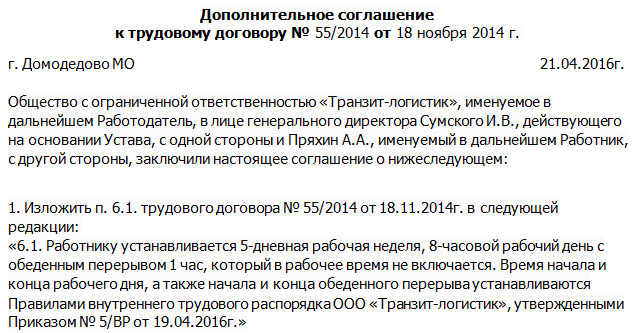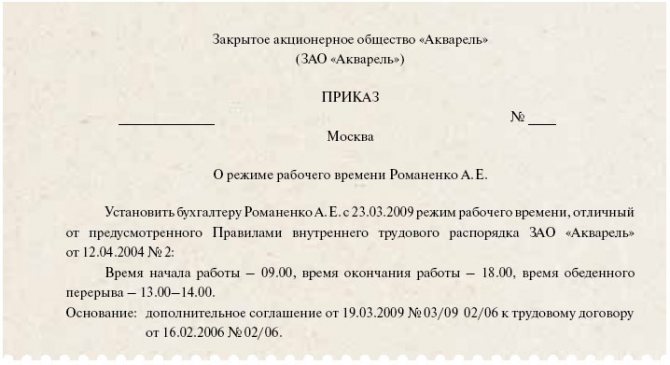Work time
The Labor Code provides a clear definition of working time and provides for various options.
Working time is considered to be the time when the employee directly works, performs exactly those actions that are assigned to him by the employment contract and job responsibilities. This time does not include any breaks. In most cases, the duration of working hours is set directly by the employer and complies with the law, amounting to no more than forty hours per week. These forty working hours are distributed differently throughout the week, depending on the so-called working hours. This regime is established by an employment agreement or contract. The main mode accepted for use is normal working hours. With it, forty hours a week are divided into five working days of eight working hours. Other options for distributing work hours are also possible. For example, during shift work, working time is distributed so that the result is no more than the permissible weekly norm.
The law allows for both increased working hours and reduced work hours, and flexible work.
Shortened work hours occur for special categories of workers. These are minors, disabled people, people working in harmful or dangerous conditions.
Work in a flexible mode or in a flexible working hours mode - in this case, the start of work, its end or the total duration of the shift can be changed by mutual agreement of the employee and the employer. At the same time, the employee must still work the established number of hours of work per week.
Working hours can not only be reduced, but also increased.
In what cases can the 8-hour working day be reduced?
The Labor Code of the Russian Federation provides a certain circle of workers with the opportunity to work less than 40 hours a week. There are two possibilities to reduce the length of the working day and week:
- reduce working hours;
- introduce part-time work.
A shortened working day is mandatory for a certain group of people. Work is paid as under a normal work schedule (except for minors).
Table: list of persons entitled to a reduced work schedule
| Category of workers | Duration of work |
| Persons under the age of majority | The following number of hours is established depending on age:
|
| Workers with disabilities | Working hours should not exceed 35 hours per week. |
| Citizens working in conditions that are recognized as harmful and dangerous | The duration of the work week is no more than 36 hours. |
| Teachers | They work no more than 36 hours a week. |
| Workers in the medical field | Work does not exceed 39 hours per week. |
| Students in part-time and part-time forms of education | May work 33 hours per week in the following cases:
|
Part time
You have the right to work part-time or a week:
- pregnant women;
- one of the parents (guardian, trustee) with a child under the age of 14 years or a child with a disability under the age of 18;
- persons caring for a sick family member.
These categories of workers cannot be refused if they have written a statement about their desire to work less. In other cases, part-time work is introduced if management and the worker reach such an agreement.
As a rule, a document evidencing such need is attached to an application requesting the right to work part-time.
For part-time work, salary will be calculated in accordance with the hours worked.
Irregular working hours
An irregular working day, according to the Labor Code, is one of the working hours and is a form of work in which workers, if necessary, can be involved in work beyond normal working hours. Such involvement can only be of an episodic nature and such involvement in work is not paid beyond the norm, but, most often, is compensated by additional leave.
If an employment contract establishes an irregular working day for an employee, this does not mean that the employee can be hired to work permanently. Article 101 of the Labor Code speaks only of occasional recruitment to work, that is, such recruitment in no case should be permanent or even of a clear periodic nature.
For employees with irregular working hours, there are also internal rules of the organization, which determine the specific time for starting and finishing work; this period of time is the normal duration of work for all employees of the organization without exception.
How to arrange an 8-hour working day in an organization
The procedure for introducing a standardized working day in an organization consists of several stages:
- Justification (the employer analyzes why an 8-hour working day suits him best).
- Determining the category of workers who will work 8 hours a day (if such a regime is not appropriate for everyone).
- Reflection of the regime in the local regulatory act of the organization and a description of all the conditions that become relevant with an 8-hour working day.
- Issuance of the relevant order. This could be an order to introduce an 8-hour working day for an individual employee, a group or the entire team. Or they introduce changes to the local acts of the enterprise.
The normalized working day is approved by the documentation:
- labor or collective agreements;
- agreements to the contracts listed above;
- internal labor regulations.
When applying for a job in an organization, a citizen expresses his consent to the proposed work schedule. All the nuances of a standardized working day and week are recorded in the employment contract.
An employment contract is a document concluded between an employer and a new employee upon employment.
The employment contract must specify the following:
- labor functions of a new employee;
- working conditions;
- working hours (hours of daily work and days off are prescribed);
- rights and obligations of the parties to the contract;
- liability for violation of the terms of the employment contract;
- duration of the agreement (if this is a fixed-term relationship), etc.

An employment contract is one of the documents that fixes the working hours of an employee of an organization.
If working conditions change in the future, an additional agreement is developed where all innovations are recorded.
Internal labor regulations (ILR) are a local regulatory act of an organization that regulates the procedure for employment and dismissal of subordinates.
The PVTR contains the following:
- length of the working day (in this case it lasts 8 hours a day);
- start and end times of daily work;
- start and end times of breaks for rest and food;
- duration of weekly uninterrupted rest - days off;
- the procedure for granting annual paid leave;
- conditions for accruing incentives for success in work;
- the procedure for penalties for violations of labor discipline.
PVTR organizations are approved by management only after the representative body of workers (for example, a trade union) expresses its opinion on the content of the document being developed.

Most often, PVTR are developed with the participation of a trade union
As a rule, an order to introduce an 8-hour working day in an organization is not issued if such a regime has been in effect from the very beginning. If a subordinate worked in a different mode, the duration of working hours may be revised.
This often happens when a person worked part-time and wants to transfer to standard conditions in order to earn more. The initiative to transfer to an 8-hour working day comes from pregnant women, students, part-time workers, and workers who have recently turned 18 years old (before this age, by law, they are entitled to a shortened working day).
If the grounds for reducing the work schedule are no longer relevant, the subordinate writes an application to transfer him to full time. The HR department, on behalf of the boss, issues a corresponding order (instruction).
The application must contain:
- name of company;
- position of the manager in whose name the document is drawn up;
- position and full name of the employee;
- request for transfer to full-time work;
- the date from which the worker is ready to start working full-time;
- employee signature.

The application for transfer to full-time work must indicate the date of the new work schedule
Next, an additional agreement to the employee’s current contract is drawn up, where the adjustments made are reflected.

The transition to an 8-hour working day is reflected in an additional agreement to the employment contract
Order on an 8-hour working day
The order for transfer to full-time work is drawn up in free form and includes the following information:
- date of introduction of the normalized working day;
- working conditions with an 8-hour working day;
- a list of breaks that a subordinate can count on during the day;
- signature of the employee (put by the employed person if he agrees with all the conditions of transfer to full time).
Management does not have the right to force a subordinate to work full time. The employed person must express his written consent to 8 hours of work per day.

The order introducing an 8-hour working day must contain information about the beginning and end of working hours
Procedure for securing and approval
The general procedure for assigning daytime working hours depends on whether it is established for one employee or for the team as a whole. The group work regime is enshrined in the PVTR.
If a different working time must be established for a particular employee, this must be reflected in the employment contract in accordance with Article 57 of the Labor Code of the Russian Federation.
The influence of working hours on the health and performance of a worker is presented in this lecture.
Part-time work
Article 93 of the Labor Code of the Russian Federation provides for the possibility of establishing part-time work. In this case, the manager can create a part-time working week and working day. It is also not at all prohibited to combine a part-time work week with part-time working hours.
As a result, part-time working hours are established in an agreement between the employer and its employees.
It is worth noting that in case of part-time work, only those hours that were actually worked by the employee are paid. In this case, length of service and vacation are calculated in the general manner.
Breaks during an 8-hour workday
During the day, the organization’s personnel can count on certain breaks in the work process. They are necessary to restore the strength of subordinates and increase their performance. Only a portion of these breaks are counted as working time and paid.
According to the law, the manager must provide employees with the following breaks:
- special breaks for heating and rest;
- periods intended for feeding the child (every 3 hours for 30 minutes);
- breaks due to the nature of the work (for example, for professional computer users).
The lunch break is not part of the working time, so no payment is made for this period. It is understood that the employee is free to use such a pause in the work process at his own discretion.
If the specifics of production do not allow time for lunch, such a break is included in working hours.
Breaks during an 8-hour working day in total should not exceed 2 hours. The employer has the right to independently decide when exactly the employee can take a break. All the nuances of suspending the work process are recorded in the internal documents of the organization.
Hours distribution
Typically, under standard conditions, an employee's work week will be either five days or six days.
It is also worth noting that it is also possible to compile a smaller number of working days; everything will depend on the adopted internal regulations in the organization (in accordance with Article 100 of the Labor Code of the Russian Federation). At the same time, a five-day work week is generally considered standard.
With a five-day work week in an organization, employees work for 5 days, 8 hours each. HR services believe that this mode is optimal, since, according to scientific research, employees will show maximum productivity. Also, do not forget about weekends, which, as a rule, fall on Saturday and Sunday, which also has a positive effect on their level of rest.
It is worth noting that there may be a different distribution of working time when using shift work. In this case, the days off may be floating.
With a part-time work week, an employee can work in the organization even just one day a week - everything will depend on his working hours established in the employment contract. So, if a specialist has only 5 working hours per week, then it will be easiest to work them in one day.
It is important that the employer has the right to independently distribute working hours by day of the working week. It is important that the total number of hours worked does not exceed 40, and the rest is at least 48 hours.
Regulations
This provision is regulated by Article 91 of the Labor Code of the Russian Federation, which provides the definition of a working day.
According to this provision, working time is that period of the day when an employee performs his direct job duties in accordance with the established internal labor regulations and the conditions specified in the employment contract.
It is worth noting that this article does not indicate the total duration of labor time.
These indicators are partially reflected in Article 94 of the Labor Code of the Russian Federation. It determines the maximum duration of a work shift for the specified categories of workers. At the same time, terms of work for other categories of specialists are not displayed.
The Labor Code of the Russian Federation establishes provisions for the duration of weekly work. Thus, in accordance with Article 94 of the Labor Code of the Russian Federation, work time during the week cannot be more than 40 hours, and rest time must be at least 48 hours.




